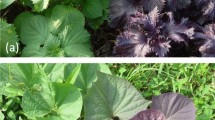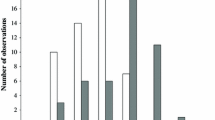Abstract
Herbivorous insects are expected to adapt to the defensive traits of local host plants. Using two closely related plants, we showed that herbivorous insects of the same species vary their adaptations according to the different traits of each of their local host plants. The leaves of the cruciferous plant Arabis flagellosa are tougher and more difficult to digest for larvae of the butterfly Pieris napi than are A. gemmifera leaves. When given A. flagellosa leaves, hatchlings from A. flagellosa fed on and ingested the leaves faster than those from A. gemmifera. Although the C/N ratios of both Arabis plants were very similar, A. gemmifera leaves were of lower intrinsic quality for larval development and were more difficult to convert to biomass than were A. flagellosa leaves. However, when A. gemmifera leaves were given, P. napi larvae originating from A. gemmifera had higher survival rates and shorter development times than did larvae originating from A. flagellosa. In addition, larvae from A. gemmifera were better able to convert leaves than were larvae from A. flagellosa. These results suggest that A. flagellosa leaves are more physically but less physiologically defended, whereas the reverse is true of A. gemmifera, and suggest that P. napi larvae adapt to the defensive traits of local host plants.





Similar content being viewed by others
References
Berenbaum M (2001) Plant–herbivore interactions. In: Fox CW, Roff DA, Fairbairn DJ (eds) Evolutionary ecology: concepts and case studies. Oxford University Press, New York, pp 303–314
Briggs D, Walters SM (1984) Plant variation and evolution, 2nd edn. Cambridge University Press, New York
Bryant JP, Chapin FSIII, Klein DR (1983) Carbon/nutrient balance of boreal plants in relation to vertebrate herbivory. Oikos 40:357–368
Carroll SP, Boyd C (1992) Host race radiation in the soapberry bug: natural history with the history. Evolution 46:1053–1069
Engler HS, Spencer KC, Gilbert LE (2000) Insect metabolism—preventing cyanide release from leaves. Nature 406:144–145
Kawecki TJ, Ebert D (2004) Conceptual issues in local adaptation. Ecol Lett 7:1225–1241
Koricheva J, Nykänen H, Gianoli E (2004) Meta-analysis of trade-offs among plant antiherbivore defenses: are plants jacks-of-all-trades, masters of all? Am Nat 163:64–75
Mauricio R (1998) Costs of resistance to natural enemies in field populations of the annual plant Arabidopsis thaliana. Am Nat 151:20–28
Mitchell-Olds T (2001) Arabidopsis thaliana and its wild relatives: a model system for ecology and evolution. Trends Ecol Evol 16:693–700
Miura K, Ohsaki N (2004) Relationship between physical leaf characteristics and growth and survival of polyphagous grasshopper nymphs, Parapodisma subastris (Orthoptera: Catantopidae). Res Popul Ecol 46:179–184
Ohsaki N, Sato Y (1994) Food plant choice of Pieris butterflies as a trade-off between parasitoid avoidance and quality of plants. Ecology 75:59–68
Pollard AJ (1992) The importance of deterrence: responses of grazing animals to plant variation. In: Fritz RS, Simms EL (eds) Plant resistance to herbivores and pathogens: ecology, evolution, and genetics. The University of Chicago Press, Chicago, pp 216–239
SAS Institute Inc. (2001) JMP The Statistical Discovery Software, version 4. 0. 5 J
Sokal RR, Rohlf FJ (1995) Biometry, 3rd edn. WH Freeman, New York
Strauss SY, Rudgers JA, Lau JA, Irwin RE (2002) Direct ecological costs of resistance to herbivory. Trends Ecol Evol 17:278–285
Williams GC (1966) Adaptation and natural selection: a critique of some current evolutionary thought. Princeton University Press, Princeton
Yang Y, Joern A (1994) Gut size changes in relation to variable food quality and body size in grasshoppers. Funct Ecol 8:36–45
Yano S, Ohsaki N (1993) The phenology and intrinsic quality of wild crucifers that determine the community structure of their herbivorous insects. Res Popul Ecol 35:151–170
Zalucki MP, Clarke AR, Malcolm SB (2002) Ecology and behavior of first instar larval Lepidoptera. Annu Rev Entomol 47:361–393
Acknowledgments
We thank the members of our laboratory for help and advice. We also thank M. Yamasaki for analysis of C/N ratios and two anonymous reviewers for comments on an earlier draft of this manuscript. This work was supported in part by the 21st Century COE Program for Innovative Food and Environmental Studies pioneered by Entomomimetic Sciences, from the Ministry of Education, Culture, Sports, Science, and Technology of Japan.
Author information
Authors and Affiliations
Corresponding author
About this article
Cite this article
Ohata, M., Furumoto, A. & Ohsaki, N. Local adaptations of larvae of the butterfly Pieris napi to physical and physiological traits of two Arabis plants (Cruciferae). Ecol Res 25, 33–39 (2010). https://doi.org/10.1007/s11284-009-0625-2
Received:
Accepted:
Published:
Issue Date:
DOI: https://doi.org/10.1007/s11284-009-0625-2




